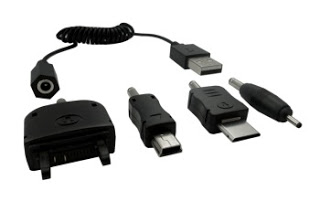While visiting (as I often do) my local computer shop, I came across a nifty tool that I thought was very interesting. Given that all they had was the Arctic C1 Portable Universal USB Charger – Solar Panel – I wanted to take a look and give it a try. The packaging indicated support for the iPhone and iPod devices and look to have a number of different connectors to use. Heck, it was $14.99 too, so you really can’t lose there, right? I’ll take you on a tour of how this device works, what I liked and what I didn’t like about it – and whether I think this is a useful tool for mobile users.
Summary: I take the Arctic C1 portable charger and put it through it’s paces to see if it can be a useful addition for mobile users or just a cheap gimmicky product.
The first thing I looked forward to was actually getting the package open to see what connectors the device came with. To my surprise, I found very few connectors. Strangely omitted from here are the micro USB connector (used on most Blackberry devices) and the 30-pin iPhone dock connector.

With the package promoting iPhone support, there had to be a way to charge it. After a couple seconds I realized that the port for the power connectors is actually a female USB port. This allows you to use any kind of USB cable to charge your device, which includes the standard Apple cable and micro USB cable. The other port (a mini-USB) allows you to connect the device to a computer for direct charging.
What’s interesting here is that this device is essentially a portable battery with a solar panel. The included manual says the battery takes about 12 hours under strong sunlight to charge with solar power. That’s definitely not possible with a full day of sun, so it’s unlikely this will help much with charging devices on a daily basis – but, we’ll see. I decided to leave the solar charger in the dash of my car overnight. Perhaps it will pickup the morning sun and charge for a while.
To my dismay, the charger didn’t pickup much morning sun before 10am. I started thinking that the device wasn’t in direct sunlight. Trying something a little different, I opened the window and held the solar panel in direct sun and it started charging. This presented me with an interesting challenge – if the device has to be out in direct sunlight, then what must I do if the rain begins and I’m not watching? Interesting problem. Also, as a design consideration, the choice to indicate charging by a red LED is a good one, but the same can’t be said for having the same light off to indicate a full charge AND not charging. I can see cases where the device might be fully charged and you think it’s not working because the light is off.
Even though the C1 is a solar charger – they recommend charging by USB. That’s never a good sign. After holding the C1 in sunlight while driving – I decided to leave it outside for a while propped up in the best direction possible on the roof of my car. I expected to be inside for a while and it didn’t look like rain was a possibility, so it was worth a shot.
Once I connected that charger to my iPhone, I essentially got about 5 mins of charging time. So, for about an hour of direct sunlight, you won’t get much of a charge at all. I thought about the challenge of getting sunlight and having the device protected from the elements (if a storm happens) and came up with the Ziploc bag solution. This should get the solar array the sun it needs, while the water doesn’t get to it.
Final Thoughts
The C1 is certainly a great idea. The price is right too. But, the difficulty in charging with light and the lack of power when the battery is actually charged leaves this product wanting. If I was still on the very remote San Blas islands in Panama, I would find this much more useful. In Canada, where power access is more plentiful – the promise of solar power not not met well enough here to ditch other options. For the amount of direct sunlight required to get any kind of useful charge – you’ll always be limited. As a battery on it’s own (using the USB charger), this device is adequate.